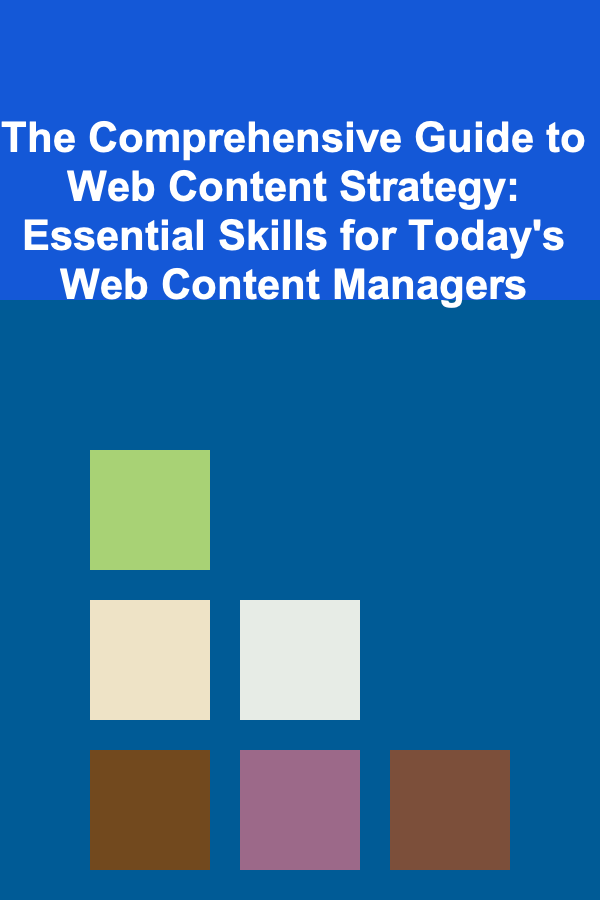
The Comprehensive Guide to Web Content Strategy: Essential Skills for Today's Web Content Managers
ebook include PDF & Audio bundle (Micro Guide)
$12.99$5.99
Limited Time Offer! Order within the next:

Web content strategy is a critical aspect of digital marketing, especially in an age where the internet is flooded with information. The role of a Web Content Manager (WCM) involves far more than just writing articles or posts. It requires a deep understanding of the brand's goals, audience needs, and how to craft content that aligns with business objectives. To excel in this ever-evolving field, WCMs must develop a well-rounded set of skills in content planning, SEO, analytics, and user experience.
This guide offers actionable steps and insights into mastering web content strategy. From creating a content roadmap to analyzing performance and fine-tuning strategies, the following sections break down the essential components every Web Content Manager should focus on.
Establishing a Strong Content Foundation
A well-defined web content strategy begins with establishing a clear foundation for what content will be created, who it will target, and why it is being created. Without this clarity, the rest of the content strategy can feel disjointed or aimless.
Define Clear Business Objectives
The first step in crafting an effective web content strategy is aligning your content with the business goals. Whether you're aiming to increase brand awareness, drive sales, or educate your audience, your content should serve these specific purposes.
Actionable Tip:
Start by collaborating with your marketing and sales teams to define the overarching business goals. Create content that addresses these objectives directly by identifying key topics, questions, and problems your audience needs answers to.
Example :
If your business goal is to drive sales, your content could focus on product benefits, use cases, customer testimonials, or comparison articles that highlight the advantages of your product over competitors.
Understand Your Audience
A strong content strategy relies heavily on understanding your audience. Web content should resonate with your target demographic, addressing their pain points, interests, and questions.
Actionable Tip:
Develop buyer personas---detailed representations of your ideal customers. Include information such as demographics, job titles, challenges, goals, and content preferences. This helps you create highly targeted and relevant content that speaks directly to your audience's needs.
Tools to Use:
- Google Analytics: For demographic insights.
- Social Media Analytics: To track audience behavior and preferences.
- Surveys/Interviews: To gather qualitative data directly from your customers.
Define Content Types and Themes
Content should be diverse and engage users in different ways. Identify the various types of content that will work best for your audience, such as blog posts, videos, case studies, infographics, podcasts, or eBooks. Additionally, establish core themes that will guide your content creation.
Actionable Tip:
Create content pillars that cover broad themes related to your business. For instance, a content pillar for a SaaS company could be "Digital Transformation," with related topics like "The Role of AI in Business," "Cloud Computing Best Practices," and "Case Studies of Digital Transformation Success."
Content Creation and Planning
Once you have a clear understanding of your business objectives and audience, it's time to focus on creating content that will attract, engage, and retain users. This involves more than just writing---it also includes content planning, organizing, and ensuring that your content serves its intended purpose.
Develop a Content Calendar
A content calendar is essential for organizing content production and publication. It helps you stay consistent in your posting and ensures that your content covers all necessary topics while aligning with key business events, holidays, or product launches.
Actionable Tip:
Use tools like Trello , Asana , or Google Sheets to plan your content. Break down your content calendar by month, week, or day and include deadlines for each piece. Include who is responsible for creating, editing, and publishing each content piece.
Example :
Plan out content that supports your upcoming product launch. Content could include a blog post series, product demo video, customer interviews, and social media teasers.
Craft Engaging, Purpose-Driven Content
Quality content is content that provides value to your audience. Craft each piece with a clear objective, whether it's to educate, entertain, inspire, or persuade. This purpose-driven approach ensures that your content isn't just filling space on the web---it's actively contributing to your audience's experience.
Actionable Tip:
Use the AIDA model (Attention, Interest, Desire, Action) to guide your content creation. Whether you're writing a blog post, an email, or a landing page, follow this formula to structure your content in a way that captures attention and moves readers toward action.
Example :
For a blog post, start with an engaging headline that grabs attention, provide valuable insights or tips that hold the reader's interest, explain the benefits of your solution or product to create desire, and include a clear CTA (Call to Action) encouraging readers to take the next step.
Optimize for Readability and Engagement
Web content should be scannable, easy to read, and visually appealing. Breaking down large chunks of text with subheadings, bullet points, and images helps retain reader attention.
Actionable Tip:
Use tools like Hemingway Editor and Grammarly to ensure your content is clear and free from errors. Keep sentences concise and avoid jargon unless it's relevant to your specific audience.
Example :
Instead of writing long paragraphs, break them down into bite-sized chunks with clear, descriptive subheadings. Integrate visuals like infographics or images to complement the content and make it more engaging.
SEO: The Backbone of Content Visibility
Search Engine Optimization (SEO) is essential for ensuring your content is discoverable. Without proper SEO practices, even the best content can remain buried on the web. As a Web Content Manager, you need to optimize content not just for search engines but also for your readers.
Conduct Thorough Keyword Research
Keyword research is the foundation of any SEO strategy. By identifying the keywords your target audience is searching for, you can tailor your content to meet these search queries.
Actionable Tip:
Use tools like Google Keyword Planner , Ahrefs , or SEMrush to find keywords with high search volume and low competition. Focus on long-tail keywords, as these are more specific and often lead to higher conversion rates.
Example :
If your website sells fitness equipment, long-tail keywords might include "best resistance bands for beginners" or "affordable home gym equipment." Incorporating these into your content will help it rank higher for those specific queries.
On-Page SEO Optimization
Once you've selected your keywords, it's important to optimize your content on the page. On-page SEO includes elements such as title tags, meta descriptions, headers, and internal linking.
Actionable Tip:
- Title Tags: Make sure the target keyword appears at the beginning.
- Meta Descriptions: Write compelling meta descriptions that include your target keyword and encourage users to click through.
- Header Tags (H1, H2, H3): Structure your content logically using header tags and include your keywords naturally.
- Internal Linking: Link to other relevant pages or blog posts on your site to improve SEO and keep users engaged.
Example :
For a blog post about "Best Home Workout Routines," ensure the title tag reads "Best Home Workout Routines for Weight Loss | [Brand Name]" and include internal links to related fitness blog posts or product pages.
Focus on Mobile Optimization and Page Speed
With mobile devices accounting for a significant portion of web traffic, mobile optimization has become a crucial part of SEO. Slow-loading pages can also negatively impact your rankings.
Actionable Tip:
- Mobile Optimization: Ensure your website is responsive and adapts to various screen sizes.
- Page Speed : Use tools like Google PageSpeed Insights to monitor your website's loading times and make necessary improvements, such as optimizing images and leveraging browser caching.
Content Distribution and Promotion
Creating excellent content is only part of the equation. To maximize your content's reach, you need to actively promote it and distribute it across multiple channels.
Leverage Social Media
Social media platforms are a great way to amplify your content. Tailor your posts to each platform's audience and encourage sharing.
Actionable Tip:
Use tools like Hootsuite or Buffer to schedule your posts and track performance. For platforms like Instagram, Pinterest, or YouTube, include relevant hashtags and tags to make your content discoverable.
Example :
If you publish a blog post on "Top 10 Healthy Recipes for Weight Loss," share bite-sized tips or images on Instagram with a link to the full blog post.
Email Marketing Campaigns
Email remains one of the most effective ways to nurture leads and engage your audience. Create targeted email campaigns that deliver valuable content directly to your subscribers.
Actionable Tip:
Segment your email list based on user behavior (e.g., purchase history, website interactions) and send personalized content that meets the needs of each segment.
Example :
Send out a monthly newsletter that highlights your latest blog posts, offers a discount on products, or shares industry insights. Tailor each email to your audience's interests.
Analyze and Optimize Performance
A successful web content strategy is continuously refined through performance analysis. Regularly reviewing content performance allows you to fine-tune your strategy, boost engagement, and optimize your SEO efforts.
Use Data Analytics to Measure Success
Tools like Google Analytics and Hotjar help track how users are interacting with your content. Focus on metrics such as page views, bounce rates, time on page, and conversion rates.
Actionable Tip:
Set specific KPIs (Key Performance Indicators) to measure content performance. For example, if you're aiming to increase lead generation, track the number of sign-ups or form submissions.
Conduct Regular Content Audits
A content audit helps identify outdated or underperforming content. Regular audits ensure that your website remains fresh and relevant, and it provides an opportunity to update older posts with new information or improved SEO.
Actionable Tip:
Use tools like Screaming Frog to crawl your website and identify pages that need updating, optimizing, or removal. Regular audits allow you to recycle content, consolidate similar pages, and refresh old content.
Conclusion
Mastering web content strategy is an ongoing process that requires a balance of creativity, technical knowledge, and strategic thinking. As a Web Content Manager, your role is not just about publishing content but aligning every piece with business goals, user needs, and SEO best practices. By understanding the fundamentals of content creation, distribution, optimization, and analysis, you can ensure that your content resonates with your audience and drives meaningful results. Stay adaptable and committed to continuous learning to excel in this dynamic field.

10 Best Tips for Successful Discount Shopping
Read More
How to Create a Backup Plan for Outdoor Events
Read More
How to Maintain Your Home's Septic System to Prevent Problems
Read More
How to Prepare Your Home for Sale with Maintenance Tips
Read More
How to Prevent and Remove Hard Water Stains in Your Home
Read More
How to Set Up a Festive Holiday Tree with Unique Ornaments
Read MoreOther Products

10 Best Tips for Successful Discount Shopping
Read More
How to Create a Backup Plan for Outdoor Events
Read More
How to Maintain Your Home's Septic System to Prevent Problems
Read More
How to Prepare Your Home for Sale with Maintenance Tips
Read More
How to Prevent and Remove Hard Water Stains in Your Home
Read More